Gender Discrimination and Equality in the Retail Workplace
VerifiedAdded on 2023/01/13
|22
|4660
|73
Report
AI Summary
This research project investigates gender inequality and discrimination in the retail sector, focusing on the workplace. It begins with an introduction outlining the aims and objectives, including an assessment of gender discrimination, particularly in the context of Morrison's. A literature review explores the concepts of gender equality, factors leading to inequality, and challenges in promoting it. The methodology section details the qualitative approach, inductive reasoning, and interpretivism philosophy used for data collection and analysis. The research employs questionnaires for data collection and analysis. The findings analyze the collected data, followed by a conclusion summarizing key findings and recommendations for reducing gender inequality and increasing employee productivity. The project also includes a reflection on the research process and a comprehensive list of references and appendices, including the questionnaire used in the research.
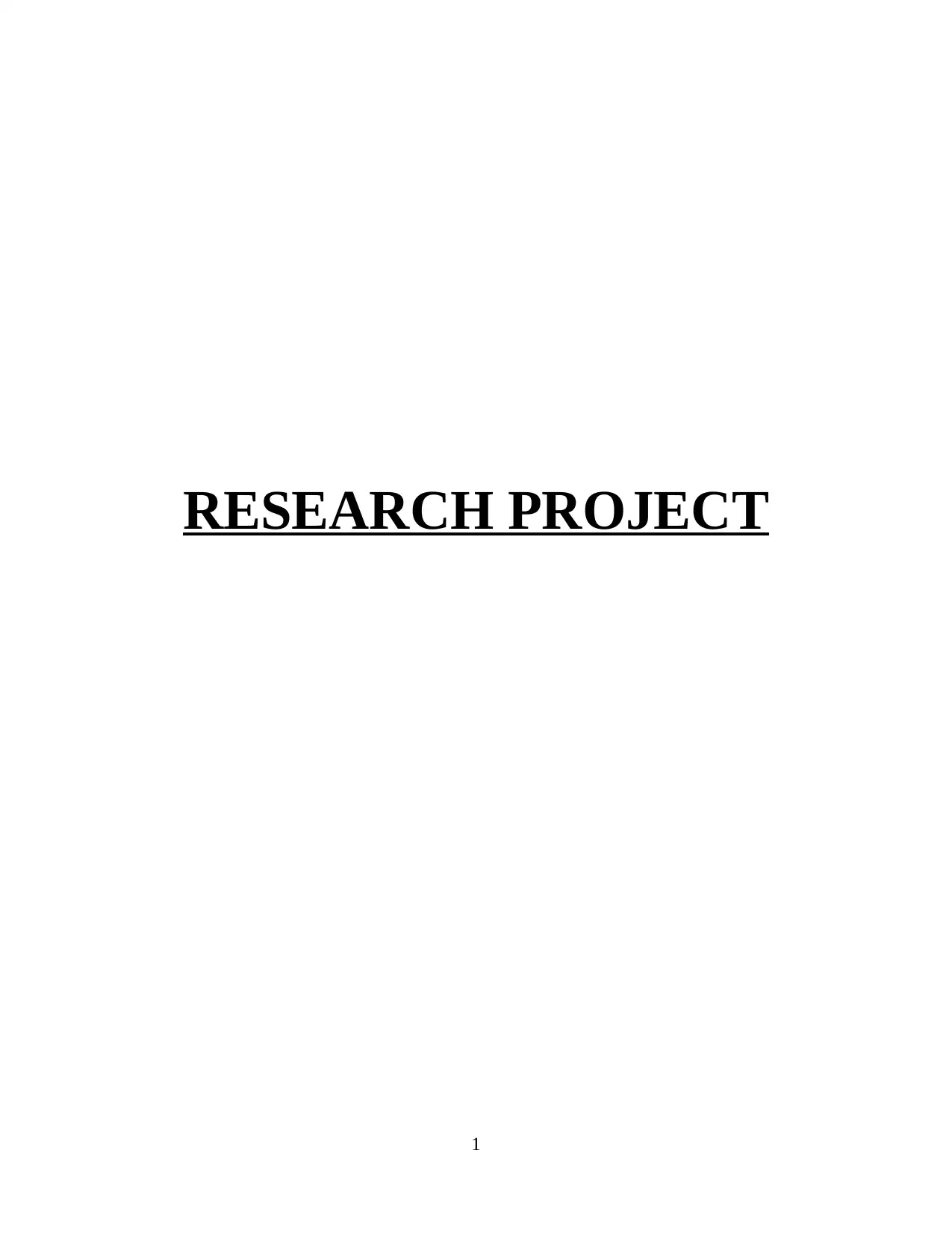
RESEARCH PROJECT
1
1
Paraphrase This Document
Need a fresh take? Get an instant paraphrase of this document with our AI Paraphraser
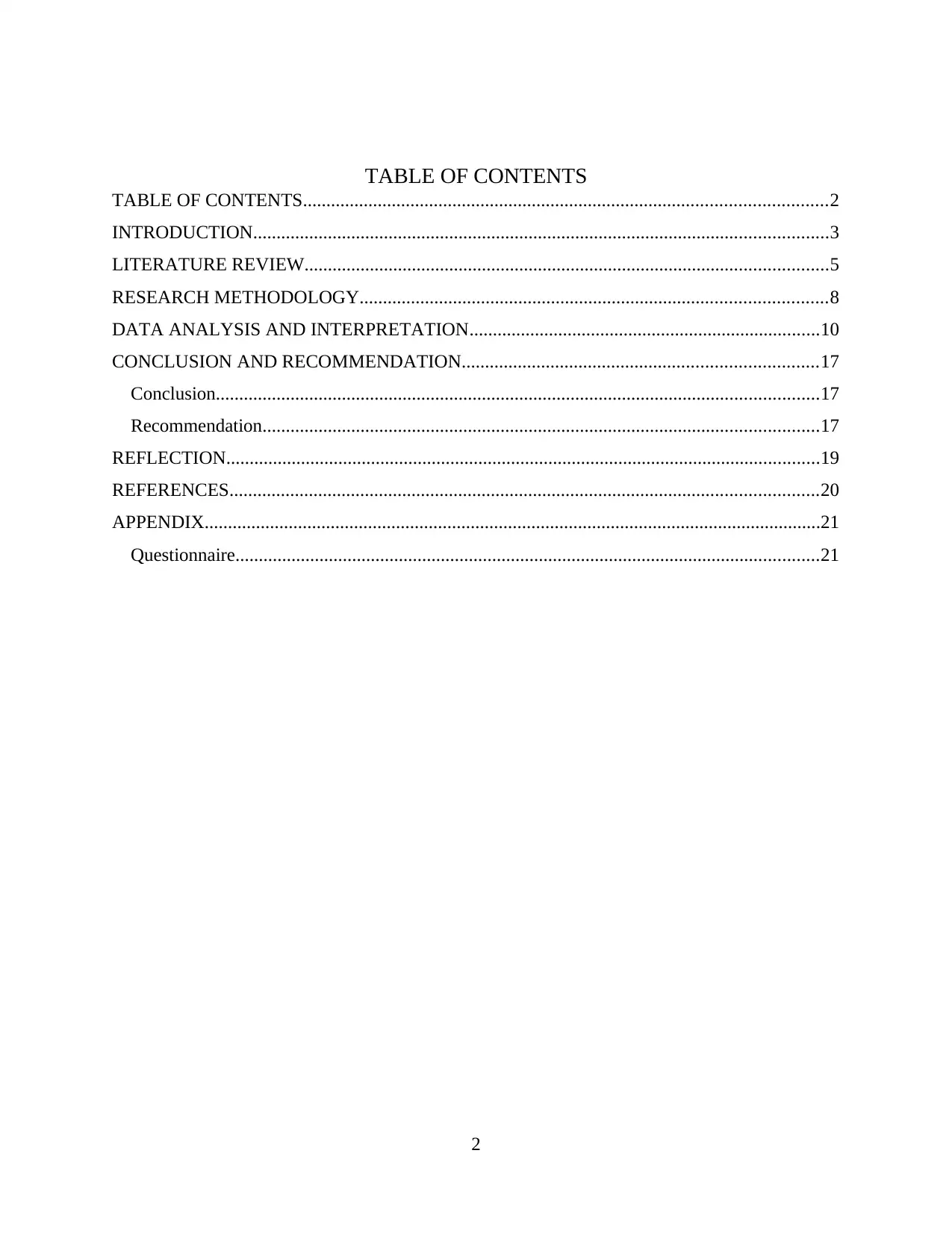
TABLE OF CONTENTS
TABLE OF CONTENTS................................................................................................................2
INTRODUCTION...........................................................................................................................3
LITERATURE REVIEW................................................................................................................5
RESEARCH METHODOLOGY....................................................................................................8
DATA ANALYSIS AND INTERPRETATION...........................................................................10
CONCLUSION AND RECOMMENDATION............................................................................17
Conclusion.................................................................................................................................17
Recommendation.......................................................................................................................17
REFLECTION...............................................................................................................................19
REFERENCES..............................................................................................................................20
APPENDIX....................................................................................................................................21
Questionnaire.............................................................................................................................21
2
TABLE OF CONTENTS................................................................................................................2
INTRODUCTION...........................................................................................................................3
LITERATURE REVIEW................................................................................................................5
RESEARCH METHODOLOGY....................................................................................................8
DATA ANALYSIS AND INTERPRETATION...........................................................................10
CONCLUSION AND RECOMMENDATION............................................................................17
Conclusion.................................................................................................................................17
Recommendation.......................................................................................................................17
REFLECTION...............................................................................................................................19
REFERENCES..............................................................................................................................20
APPENDIX....................................................................................................................................21
Questionnaire.............................................................................................................................21
2
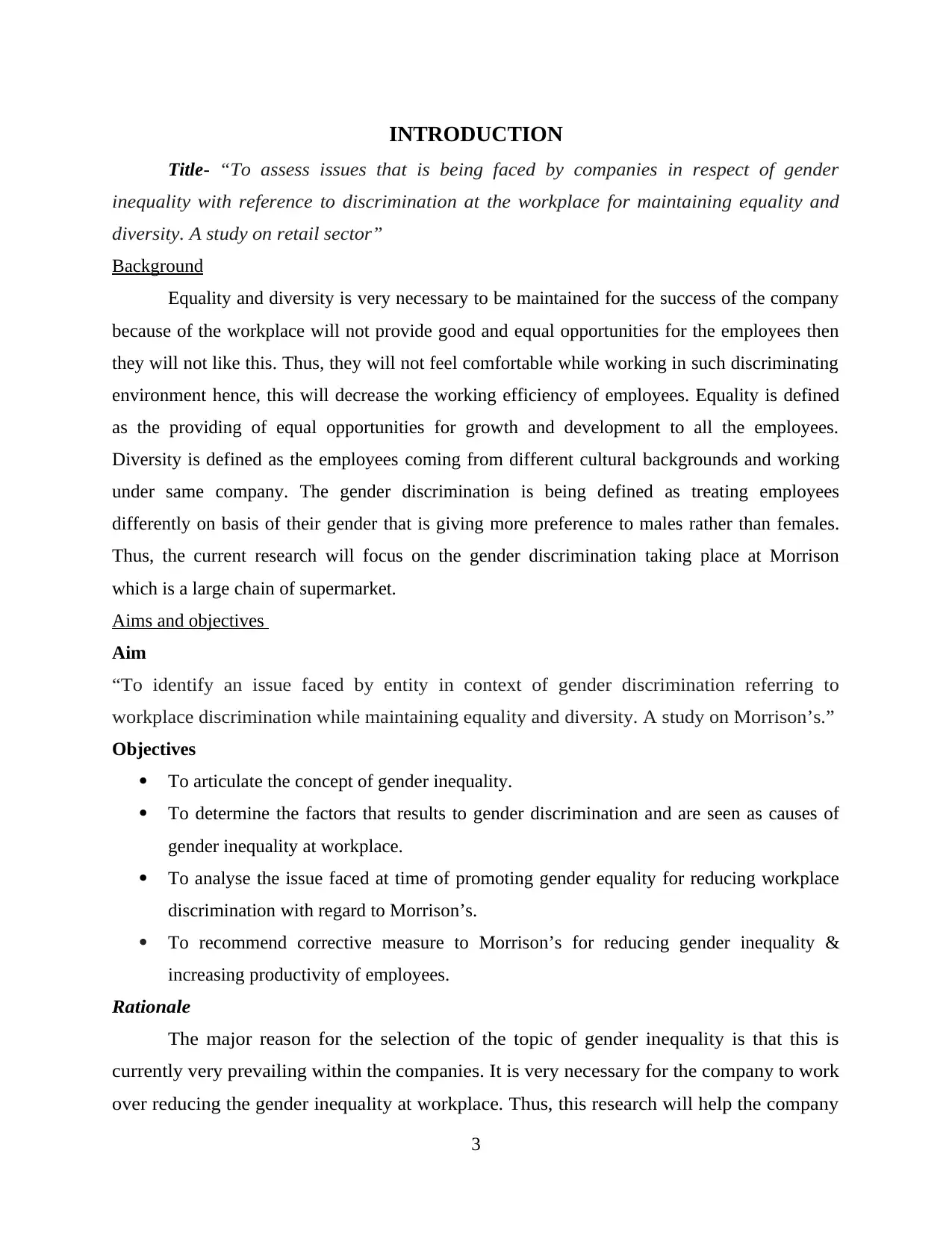
INTRODUCTION
Title- “To assess issues that is being faced by companies in respect of gender
inequality with reference to discrimination at the workplace for maintaining equality and
diversity. A study on retail sector”
Background
Equality and diversity is very necessary to be maintained for the success of the company
because of the workplace will not provide good and equal opportunities for the employees then
they will not like this. Thus, they will not feel comfortable while working in such discriminating
environment hence, this will decrease the working efficiency of employees. Equality is defined
as the providing of equal opportunities for growth and development to all the employees.
Diversity is defined as the employees coming from different cultural backgrounds and working
under same company. The gender discrimination is being defined as treating employees
differently on basis of their gender that is giving more preference to males rather than females.
Thus, the current research will focus on the gender discrimination taking place at Morrison
which is a large chain of supermarket.
Aims and objectives
Aim
“To identify an issue faced by entity in context of gender discrimination referring to
workplace discrimination while maintaining equality and diversity. A study on Morrison’s.”
Objectives
To articulate the concept of gender inequality.
To determine the factors that results to gender discrimination and are seen as causes of
gender inequality at workplace.
To analyse the issue faced at time of promoting gender equality for reducing workplace
discrimination with regard to Morrison’s.
To recommend corrective measure to Morrison’s for reducing gender inequality &
increasing productivity of employees.
Rationale
The major reason for the selection of the topic of gender inequality is that this is
currently very prevailing within the companies. It is very necessary for the company to work
over reducing the gender inequality at workplace. Thus, this research will help the company
3
Title- “To assess issues that is being faced by companies in respect of gender
inequality with reference to discrimination at the workplace for maintaining equality and
diversity. A study on retail sector”
Background
Equality and diversity is very necessary to be maintained for the success of the company
because of the workplace will not provide good and equal opportunities for the employees then
they will not like this. Thus, they will not feel comfortable while working in such discriminating
environment hence, this will decrease the working efficiency of employees. Equality is defined
as the providing of equal opportunities for growth and development to all the employees.
Diversity is defined as the employees coming from different cultural backgrounds and working
under same company. The gender discrimination is being defined as treating employees
differently on basis of their gender that is giving more preference to males rather than females.
Thus, the current research will focus on the gender discrimination taking place at Morrison
which is a large chain of supermarket.
Aims and objectives
Aim
“To identify an issue faced by entity in context of gender discrimination referring to
workplace discrimination while maintaining equality and diversity. A study on Morrison’s.”
Objectives
To articulate the concept of gender inequality.
To determine the factors that results to gender discrimination and are seen as causes of
gender inequality at workplace.
To analyse the issue faced at time of promoting gender equality for reducing workplace
discrimination with regard to Morrison’s.
To recommend corrective measure to Morrison’s for reducing gender inequality &
increasing productivity of employees.
Rationale
The major reason for the selection of the topic of gender inequality is that this is
currently very prevailing within the companies. It is very necessary for the company to work
over reducing the gender inequality at workplace. Thus, this research will help the company
3
⊘ This is a preview!⊘
Do you want full access?
Subscribe today to unlock all pages.

Trusted by 1+ million students worldwide
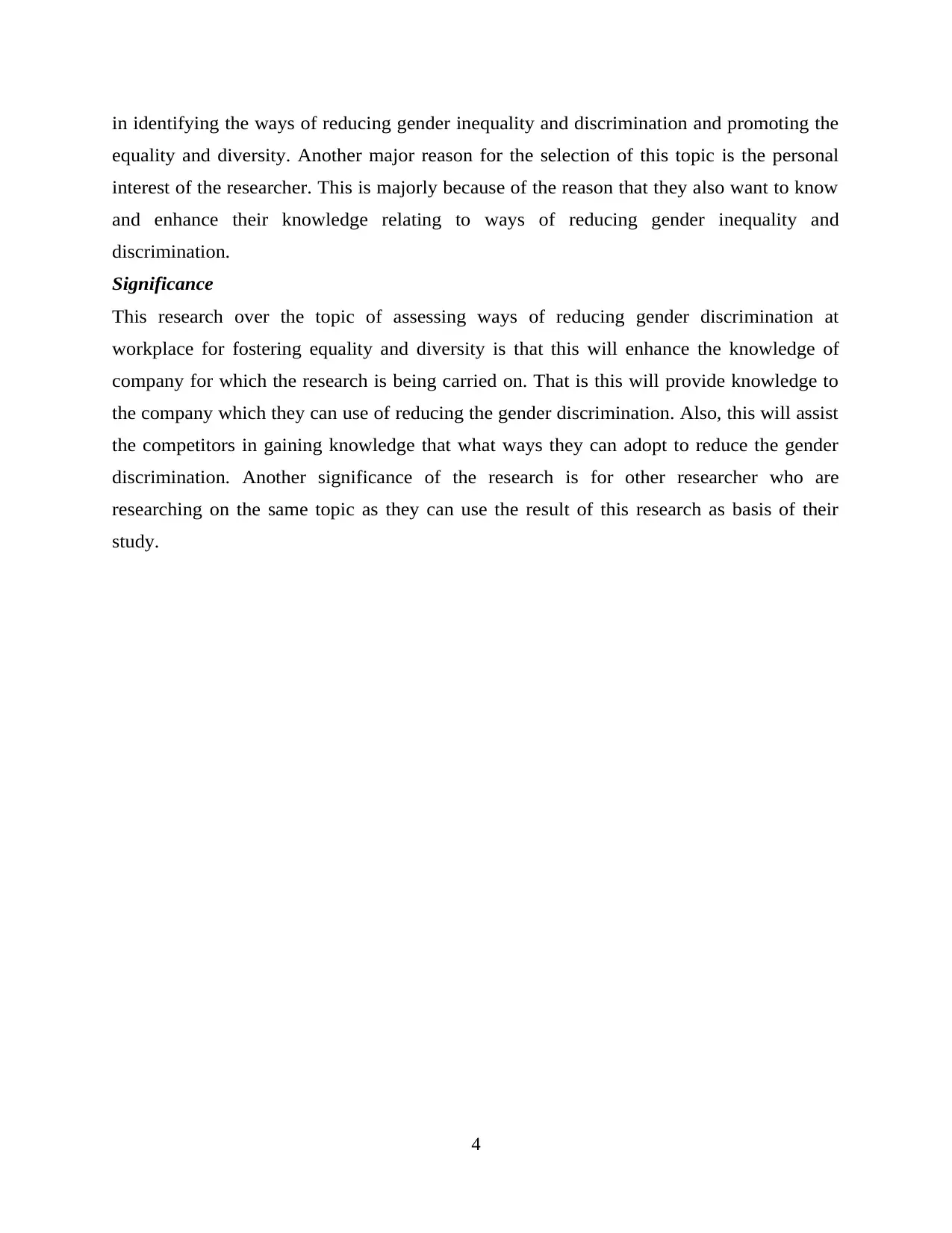
in identifying the ways of reducing gender inequality and discrimination and promoting the
equality and diversity. Another major reason for the selection of this topic is the personal
interest of the researcher. This is majorly because of the reason that they also want to know
and enhance their knowledge relating to ways of reducing gender inequality and
discrimination.
Significance
This research over the topic of assessing ways of reducing gender discrimination at
workplace for fostering equality and diversity is that this will enhance the knowledge of
company for which the research is being carried on. That is this will provide knowledge to
the company which they can use of reducing the gender discrimination. Also, this will assist
the competitors in gaining knowledge that what ways they can adopt to reduce the gender
discrimination. Another significance of the research is for other researcher who are
researching on the same topic as they can use the result of this research as basis of their
study.
4
equality and diversity. Another major reason for the selection of this topic is the personal
interest of the researcher. This is majorly because of the reason that they also want to know
and enhance their knowledge relating to ways of reducing gender inequality and
discrimination.
Significance
This research over the topic of assessing ways of reducing gender discrimination at
workplace for fostering equality and diversity is that this will enhance the knowledge of
company for which the research is being carried on. That is this will provide knowledge to
the company which they can use of reducing the gender discrimination. Also, this will assist
the competitors in gaining knowledge that what ways they can adopt to reduce the gender
discrimination. Another significance of the research is for other researcher who are
researching on the same topic as they can use the result of this research as basis of their
study.
4
Paraphrase This Document
Need a fresh take? Get an instant paraphrase of this document with our AI Paraphraser
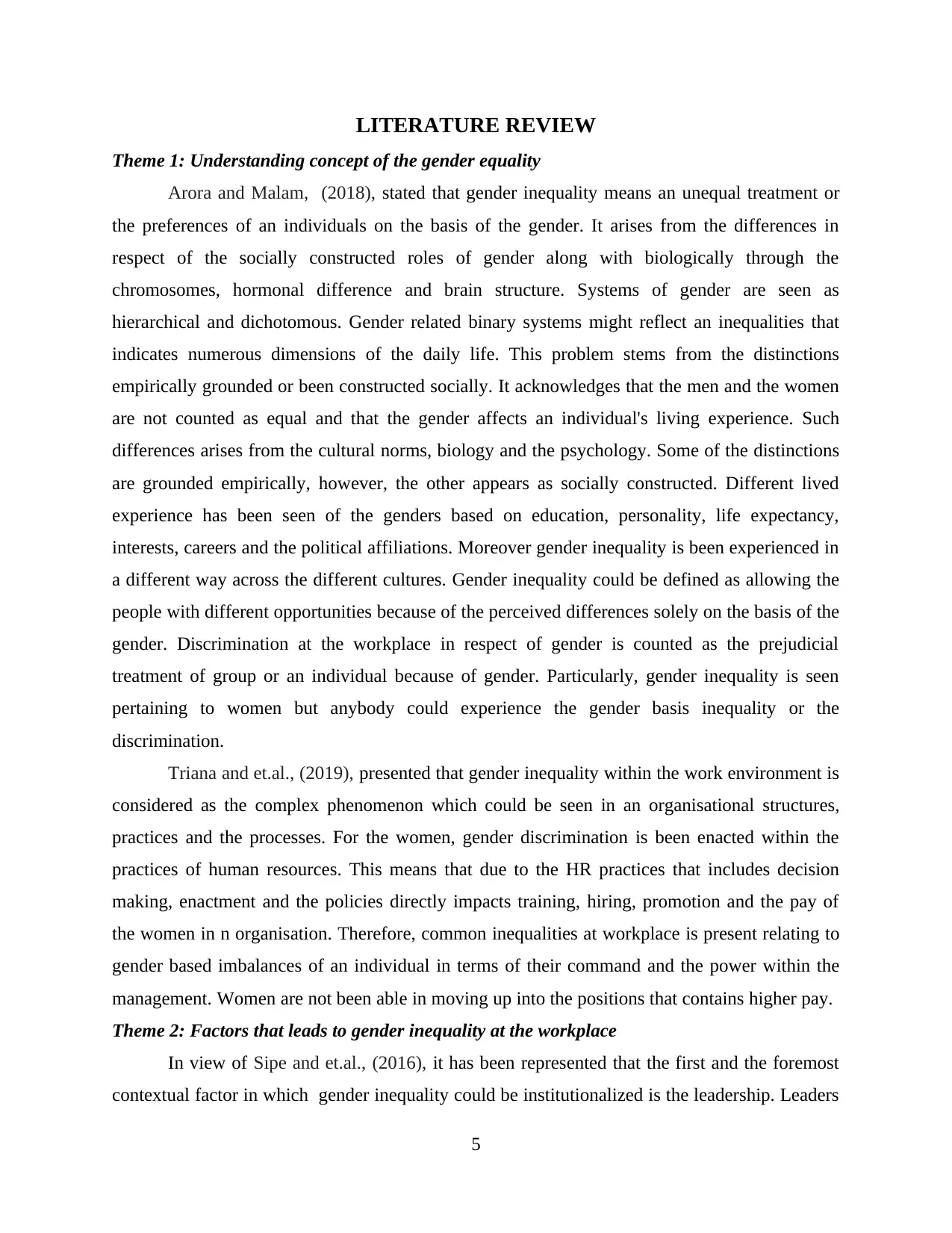
LITERATURE REVIEW
Theme 1: Understanding concept of the gender equality
Arora and Malam, (2018), stated that gender inequality means an unequal treatment or
the preferences of an individuals on the basis of the gender. It arises from the differences in
respect of the socially constructed roles of gender along with biologically through the
chromosomes, hormonal difference and brain structure. Systems of gender are seen as
hierarchical and dichotomous. Gender related binary systems might reflect an inequalities that
indicates numerous dimensions of the daily life. This problem stems from the distinctions
empirically grounded or been constructed socially. It acknowledges that the men and the women
are not counted as equal and that the gender affects an individual's living experience. Such
differences arises from the cultural norms, biology and the psychology. Some of the distinctions
are grounded empirically, however, the other appears as socially constructed. Different lived
experience has been seen of the genders based on education, personality, life expectancy,
interests, careers and the political affiliations. Moreover gender inequality is been experienced in
a different way across the different cultures. Gender inequality could be defined as allowing the
people with different opportunities because of the perceived differences solely on the basis of the
gender. Discrimination at the workplace in respect of gender is counted as the prejudicial
treatment of group or an individual because of gender. Particularly, gender inequality is seen
pertaining to women but anybody could experience the gender basis inequality or the
discrimination.
Triana and et.al., (2019), presented that gender inequality within the work environment is
considered as the complex phenomenon which could be seen in an organisational structures,
practices and the processes. For the women, gender discrimination is been enacted within the
practices of human resources. This means that due to the HR practices that includes decision
making, enactment and the policies directly impacts training, hiring, promotion and the pay of
the women in n organisation. Therefore, common inequalities at workplace is present relating to
gender based imbalances of an individual in terms of their command and the power within the
management. Women are not been able in moving up into the positions that contains higher pay.
Theme 2: Factors that leads to gender inequality at the workplace
In view of Sipe and et.al., (2016), it has been represented that the first and the foremost
contextual factor in which gender inequality could be institutionalized is the leadership. Leaders
5
Theme 1: Understanding concept of the gender equality
Arora and Malam, (2018), stated that gender inequality means an unequal treatment or
the preferences of an individuals on the basis of the gender. It arises from the differences in
respect of the socially constructed roles of gender along with biologically through the
chromosomes, hormonal difference and brain structure. Systems of gender are seen as
hierarchical and dichotomous. Gender related binary systems might reflect an inequalities that
indicates numerous dimensions of the daily life. This problem stems from the distinctions
empirically grounded or been constructed socially. It acknowledges that the men and the women
are not counted as equal and that the gender affects an individual's living experience. Such
differences arises from the cultural norms, biology and the psychology. Some of the distinctions
are grounded empirically, however, the other appears as socially constructed. Different lived
experience has been seen of the genders based on education, personality, life expectancy,
interests, careers and the political affiliations. Moreover gender inequality is been experienced in
a different way across the different cultures. Gender inequality could be defined as allowing the
people with different opportunities because of the perceived differences solely on the basis of the
gender. Discrimination at the workplace in respect of gender is counted as the prejudicial
treatment of group or an individual because of gender. Particularly, gender inequality is seen
pertaining to women but anybody could experience the gender basis inequality or the
discrimination.
Triana and et.al., (2019), presented that gender inequality within the work environment is
considered as the complex phenomenon which could be seen in an organisational structures,
practices and the processes. For the women, gender discrimination is been enacted within the
practices of human resources. This means that due to the HR practices that includes decision
making, enactment and the policies directly impacts training, hiring, promotion and the pay of
the women in n organisation. Therefore, common inequalities at workplace is present relating to
gender based imbalances of an individual in terms of their command and the power within the
management. Women are not been able in moving up into the positions that contains higher pay.
Theme 2: Factors that leads to gender inequality at the workplace
In view of Sipe and et.al., (2016), it has been represented that the first and the foremost
contextual factor in which gender inequality could be institutionalized is the leadership. Leaders
5
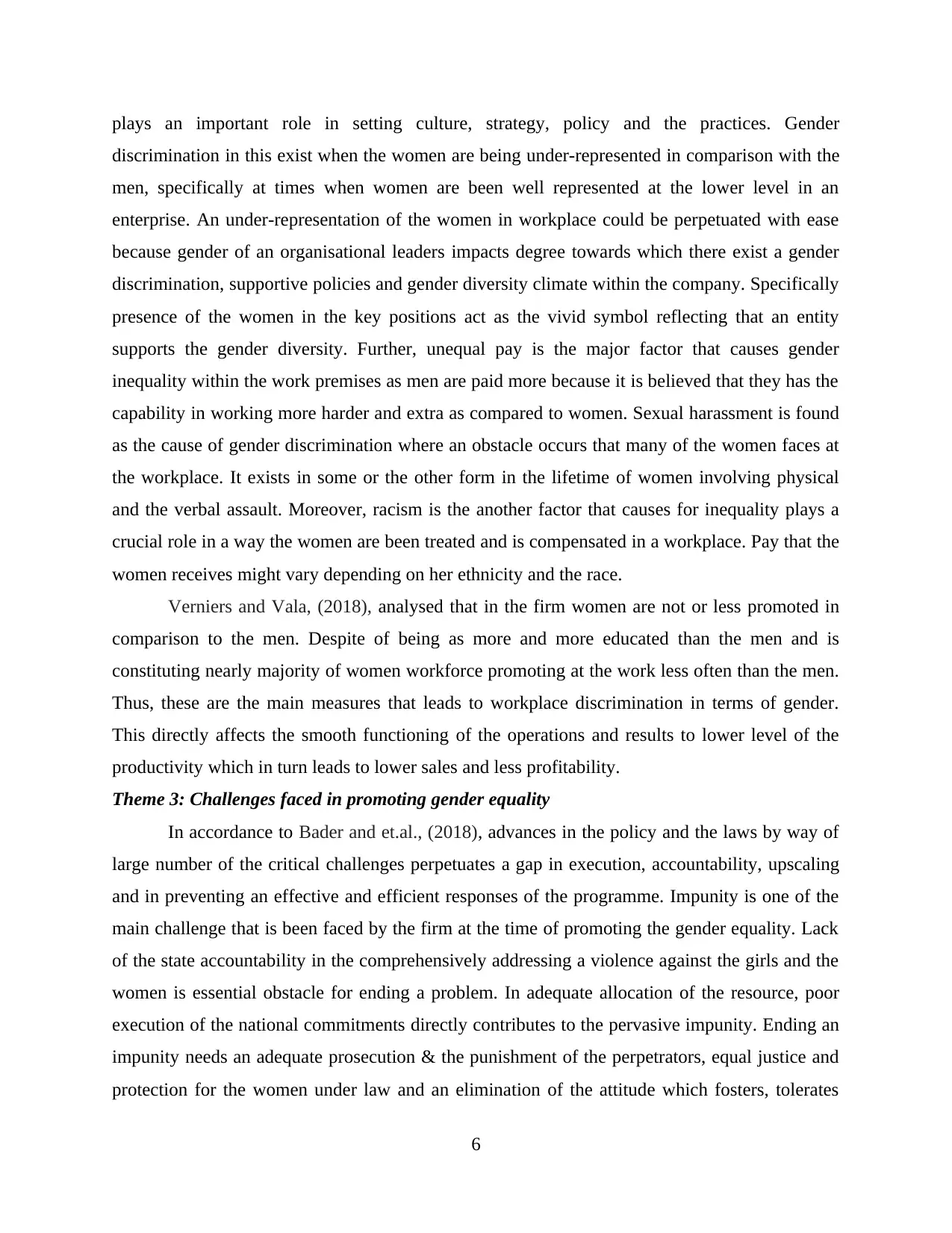
plays an important role in setting culture, strategy, policy and the practices. Gender
discrimination in this exist when the women are being under-represented in comparison with the
men, specifically at times when women are been well represented at the lower level in an
enterprise. An under-representation of the women in workplace could be perpetuated with ease
because gender of an organisational leaders impacts degree towards which there exist a gender
discrimination, supportive policies and gender diversity climate within the company. Specifically
presence of the women in the key positions act as the vivid symbol reflecting that an entity
supports the gender diversity. Further, unequal pay is the major factor that causes gender
inequality within the work premises as men are paid more because it is believed that they has the
capability in working more harder and extra as compared to women. Sexual harassment is found
as the cause of gender discrimination where an obstacle occurs that many of the women faces at
the workplace. It exists in some or the other form in the lifetime of women involving physical
and the verbal assault. Moreover, racism is the another factor that causes for inequality plays a
crucial role in a way the women are been treated and is compensated in a workplace. Pay that the
women receives might vary depending on her ethnicity and the race.
Verniers and Vala, (2018), analysed that in the firm women are not or less promoted in
comparison to the men. Despite of being as more and more educated than the men and is
constituting nearly majority of women workforce promoting at the work less often than the men.
Thus, these are the main measures that leads to workplace discrimination in terms of gender.
This directly affects the smooth functioning of the operations and results to lower level of the
productivity which in turn leads to lower sales and less profitability.
Theme 3: Challenges faced in promoting gender equality
In accordance to Bader and et.al., (2018), advances in the policy and the laws by way of
large number of the critical challenges perpetuates a gap in execution, accountability, upscaling
and in preventing an effective and efficient responses of the programme. Impunity is one of the
main challenge that is been faced by the firm at the time of promoting the gender equality. Lack
of the state accountability in the comprehensively addressing a violence against the girls and the
women is essential obstacle for ending a problem. In adequate allocation of the resource, poor
execution of the national commitments directly contributes to the pervasive impunity. Ending an
impunity needs an adequate prosecution & the punishment of the perpetrators, equal justice and
protection for the women under law and an elimination of the attitude which fosters, tolerates
6
discrimination in this exist when the women are being under-represented in comparison with the
men, specifically at times when women are been well represented at the lower level in an
enterprise. An under-representation of the women in workplace could be perpetuated with ease
because gender of an organisational leaders impacts degree towards which there exist a gender
discrimination, supportive policies and gender diversity climate within the company. Specifically
presence of the women in the key positions act as the vivid symbol reflecting that an entity
supports the gender diversity. Further, unequal pay is the major factor that causes gender
inequality within the work premises as men are paid more because it is believed that they has the
capability in working more harder and extra as compared to women. Sexual harassment is found
as the cause of gender discrimination where an obstacle occurs that many of the women faces at
the workplace. It exists in some or the other form in the lifetime of women involving physical
and the verbal assault. Moreover, racism is the another factor that causes for inequality plays a
crucial role in a way the women are been treated and is compensated in a workplace. Pay that the
women receives might vary depending on her ethnicity and the race.
Verniers and Vala, (2018), analysed that in the firm women are not or less promoted in
comparison to the men. Despite of being as more and more educated than the men and is
constituting nearly majority of women workforce promoting at the work less often than the men.
Thus, these are the main measures that leads to workplace discrimination in terms of gender.
This directly affects the smooth functioning of the operations and results to lower level of the
productivity which in turn leads to lower sales and less profitability.
Theme 3: Challenges faced in promoting gender equality
In accordance to Bader and et.al., (2018), advances in the policy and the laws by way of
large number of the critical challenges perpetuates a gap in execution, accountability, upscaling
and in preventing an effective and efficient responses of the programme. Impunity is one of the
main challenge that is been faced by the firm at the time of promoting the gender equality. Lack
of the state accountability in the comprehensively addressing a violence against the girls and the
women is essential obstacle for ending a problem. In adequate allocation of the resource, poor
execution of the national commitments directly contributes to the pervasive impunity. Ending an
impunity needs an adequate prosecution & the punishment of the perpetrators, equal justice and
protection for the women under law and an elimination of the attitude which fosters, tolerates
6
⊘ This is a preview!⊘
Do you want full access?
Subscribe today to unlock all pages.

Trusted by 1+ million students worldwide
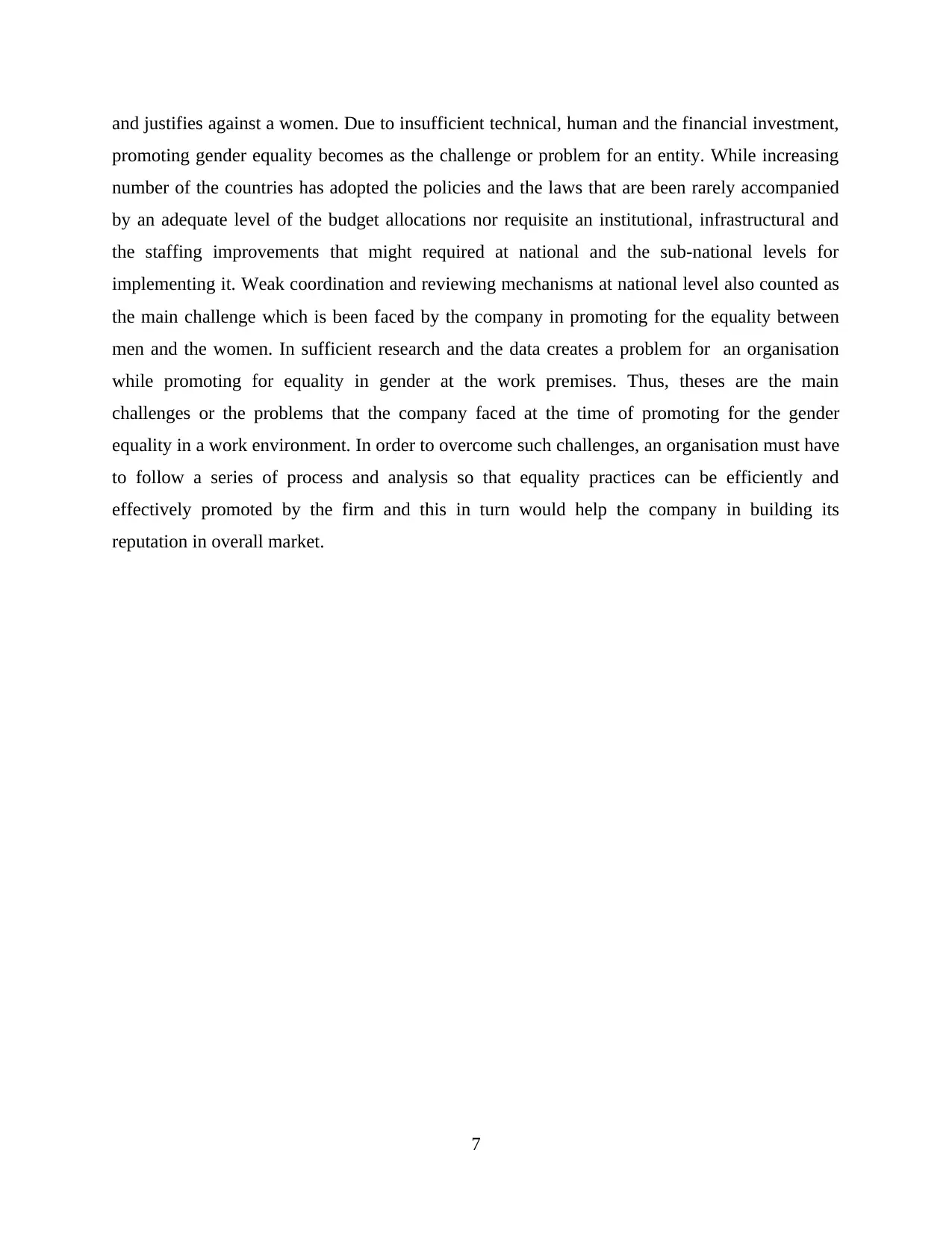
and justifies against a women. Due to insufficient technical, human and the financial investment,
promoting gender equality becomes as the challenge or problem for an entity. While increasing
number of the countries has adopted the policies and the laws that are been rarely accompanied
by an adequate level of the budget allocations nor requisite an institutional, infrastructural and
the staffing improvements that might required at national and the sub-national levels for
implementing it. Weak coordination and reviewing mechanisms at national level also counted as
the main challenge which is been faced by the company in promoting for the equality between
men and the women. In sufficient research and the data creates a problem for an organisation
while promoting for equality in gender at the work premises. Thus, theses are the main
challenges or the problems that the company faced at the time of promoting for the gender
equality in a work environment. In order to overcome such challenges, an organisation must have
to follow a series of process and analysis so that equality practices can be efficiently and
effectively promoted by the firm and this in turn would help the company in building its
reputation in overall market.
7
promoting gender equality becomes as the challenge or problem for an entity. While increasing
number of the countries has adopted the policies and the laws that are been rarely accompanied
by an adequate level of the budget allocations nor requisite an institutional, infrastructural and
the staffing improvements that might required at national and the sub-national levels for
implementing it. Weak coordination and reviewing mechanisms at national level also counted as
the main challenge which is been faced by the company in promoting for the equality between
men and the women. In sufficient research and the data creates a problem for an organisation
while promoting for equality in gender at the work premises. Thus, theses are the main
challenges or the problems that the company faced at the time of promoting for the gender
equality in a work environment. In order to overcome such challenges, an organisation must have
to follow a series of process and analysis so that equality practices can be efficiently and
effectively promoted by the firm and this in turn would help the company in building its
reputation in overall market.
7
Paraphrase This Document
Need a fresh take? Get an instant paraphrase of this document with our AI Paraphraser
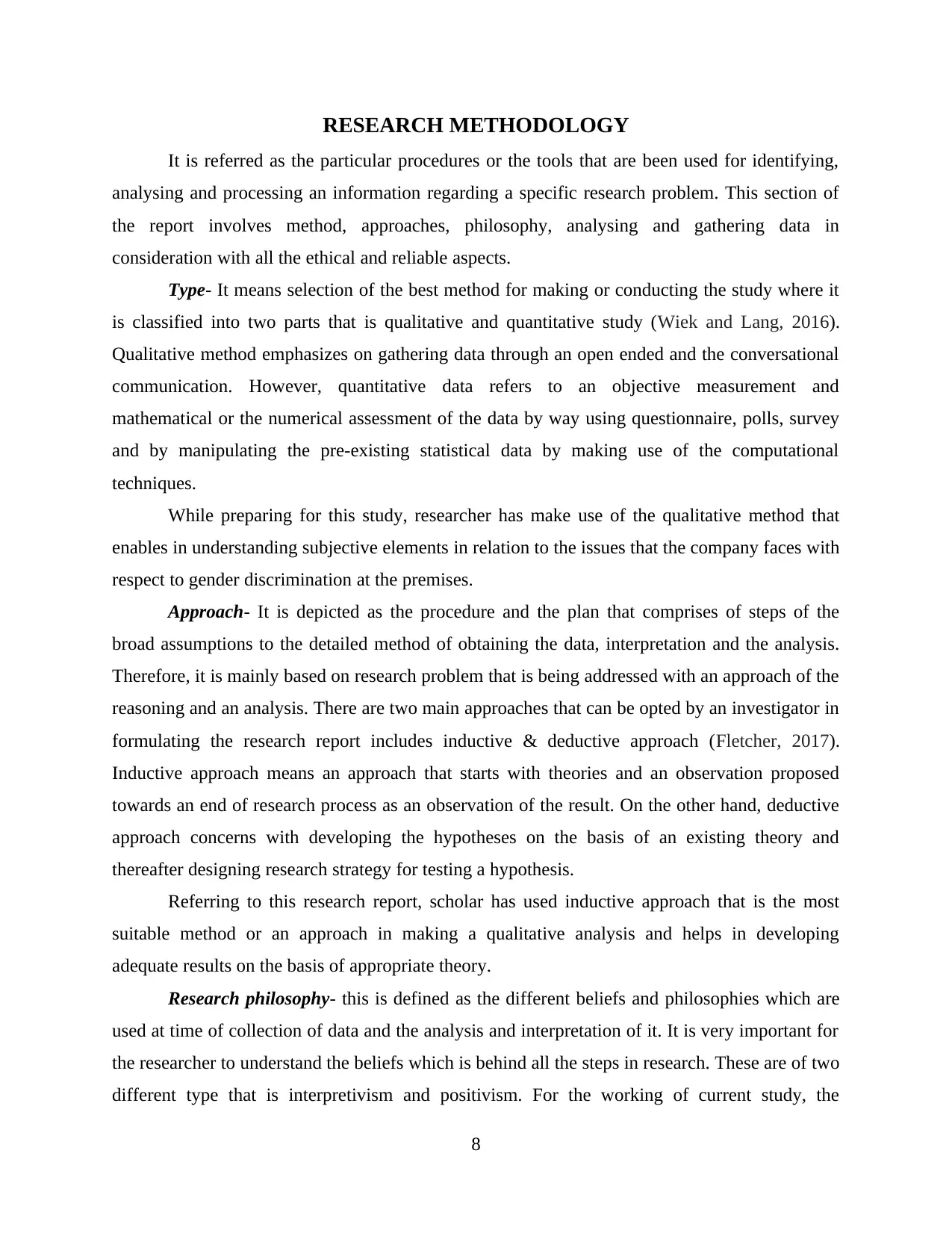
RESEARCH METHODOLOGY
It is referred as the particular procedures or the tools that are been used for identifying,
analysing and processing an information regarding a specific research problem. This section of
the report involves method, approaches, philosophy, analysing and gathering data in
consideration with all the ethical and reliable aspects.
Type- It means selection of the best method for making or conducting the study where it
is classified into two parts that is qualitative and quantitative study (Wiek and Lang, 2016).
Qualitative method emphasizes on gathering data through an open ended and the conversational
communication. However, quantitative data refers to an objective measurement and
mathematical or the numerical assessment of the data by way using questionnaire, polls, survey
and by manipulating the pre-existing statistical data by making use of the computational
techniques.
While preparing for this study, researcher has make use of the qualitative method that
enables in understanding subjective elements in relation to the issues that the company faces with
respect to gender discrimination at the premises.
Approach- It is depicted as the procedure and the plan that comprises of steps of the
broad assumptions to the detailed method of obtaining the data, interpretation and the analysis.
Therefore, it is mainly based on research problem that is being addressed with an approach of the
reasoning and an analysis. There are two main approaches that can be opted by an investigator in
formulating the research report includes inductive & deductive approach (Fletcher, 2017).
Inductive approach means an approach that starts with theories and an observation proposed
towards an end of research process as an observation of the result. On the other hand, deductive
approach concerns with developing the hypotheses on the basis of an existing theory and
thereafter designing research strategy for testing a hypothesis.
Referring to this research report, scholar has used inductive approach that is the most
suitable method or an approach in making a qualitative analysis and helps in developing
adequate results on the basis of appropriate theory.
Research philosophy- this is defined as the different beliefs and philosophies which are
used at time of collection of data and the analysis and interpretation of it. It is very important for
the researcher to understand the beliefs which is behind all the steps in research. These are of two
different type that is interpretivism and positivism. For the working of current study, the
8
It is referred as the particular procedures or the tools that are been used for identifying,
analysing and processing an information regarding a specific research problem. This section of
the report involves method, approaches, philosophy, analysing and gathering data in
consideration with all the ethical and reliable aspects.
Type- It means selection of the best method for making or conducting the study where it
is classified into two parts that is qualitative and quantitative study (Wiek and Lang, 2016).
Qualitative method emphasizes on gathering data through an open ended and the conversational
communication. However, quantitative data refers to an objective measurement and
mathematical or the numerical assessment of the data by way using questionnaire, polls, survey
and by manipulating the pre-existing statistical data by making use of the computational
techniques.
While preparing for this study, researcher has make use of the qualitative method that
enables in understanding subjective elements in relation to the issues that the company faces with
respect to gender discrimination at the premises.
Approach- It is depicted as the procedure and the plan that comprises of steps of the
broad assumptions to the detailed method of obtaining the data, interpretation and the analysis.
Therefore, it is mainly based on research problem that is being addressed with an approach of the
reasoning and an analysis. There are two main approaches that can be opted by an investigator in
formulating the research report includes inductive & deductive approach (Fletcher, 2017).
Inductive approach means an approach that starts with theories and an observation proposed
towards an end of research process as an observation of the result. On the other hand, deductive
approach concerns with developing the hypotheses on the basis of an existing theory and
thereafter designing research strategy for testing a hypothesis.
Referring to this research report, scholar has used inductive approach that is the most
suitable method or an approach in making a qualitative analysis and helps in developing
adequate results on the basis of appropriate theory.
Research philosophy- this is defined as the different beliefs and philosophies which are
used at time of collection of data and the analysis and interpretation of it. It is very important for
the researcher to understand the beliefs which is behind all the steps in research. These are of two
different type that is interpretivism and positivism. For the working of current study, the
8
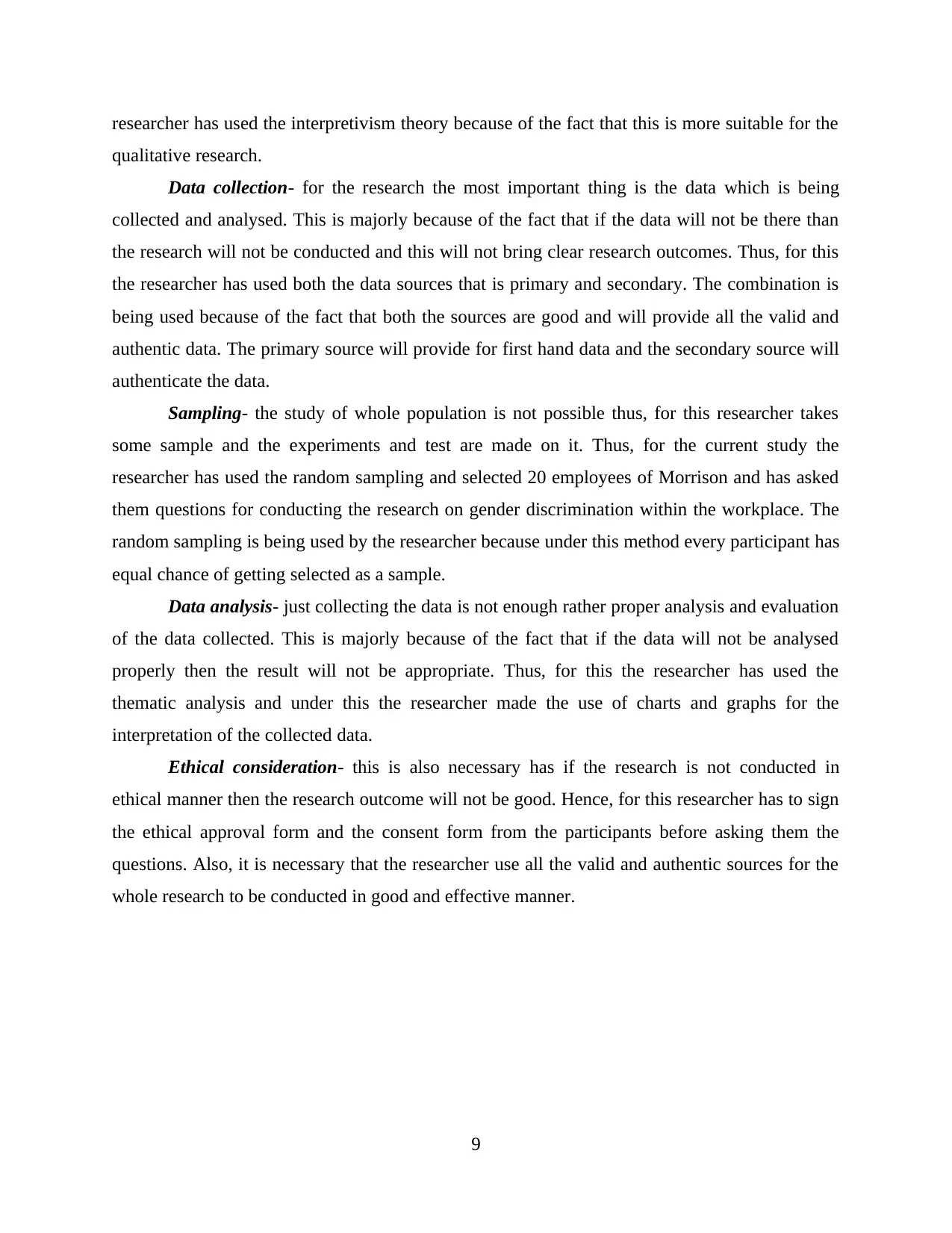
researcher has used the interpretivism theory because of the fact that this is more suitable for the
qualitative research.
Data collection- for the research the most important thing is the data which is being
collected and analysed. This is majorly because of the fact that if the data will not be there than
the research will not be conducted and this will not bring clear research outcomes. Thus, for this
the researcher has used both the data sources that is primary and secondary. The combination is
being used because of the fact that both the sources are good and will provide all the valid and
authentic data. The primary source will provide for first hand data and the secondary source will
authenticate the data.
Sampling- the study of whole population is not possible thus, for this researcher takes
some sample and the experiments and test are made on it. Thus, for the current study the
researcher has used the random sampling and selected 20 employees of Morrison and has asked
them questions for conducting the research on gender discrimination within the workplace. The
random sampling is being used by the researcher because under this method every participant has
equal chance of getting selected as a sample.
Data analysis- just collecting the data is not enough rather proper analysis and evaluation
of the data collected. This is majorly because of the fact that if the data will not be analysed
properly then the result will not be appropriate. Thus, for this the researcher has used the
thematic analysis and under this the researcher made the use of charts and graphs for the
interpretation of the collected data.
Ethical consideration- this is also necessary has if the research is not conducted in
ethical manner then the research outcome will not be good. Hence, for this researcher has to sign
the ethical approval form and the consent form from the participants before asking them the
questions. Also, it is necessary that the researcher use all the valid and authentic sources for the
whole research to be conducted in good and effective manner.
9
qualitative research.
Data collection- for the research the most important thing is the data which is being
collected and analysed. This is majorly because of the fact that if the data will not be there than
the research will not be conducted and this will not bring clear research outcomes. Thus, for this
the researcher has used both the data sources that is primary and secondary. The combination is
being used because of the fact that both the sources are good and will provide all the valid and
authentic data. The primary source will provide for first hand data and the secondary source will
authenticate the data.
Sampling- the study of whole population is not possible thus, for this researcher takes
some sample and the experiments and test are made on it. Thus, for the current study the
researcher has used the random sampling and selected 20 employees of Morrison and has asked
them questions for conducting the research on gender discrimination within the workplace. The
random sampling is being used by the researcher because under this method every participant has
equal chance of getting selected as a sample.
Data analysis- just collecting the data is not enough rather proper analysis and evaluation
of the data collected. This is majorly because of the fact that if the data will not be analysed
properly then the result will not be appropriate. Thus, for this the researcher has used the
thematic analysis and under this the researcher made the use of charts and graphs for the
interpretation of the collected data.
Ethical consideration- this is also necessary has if the research is not conducted in
ethical manner then the research outcome will not be good. Hence, for this researcher has to sign
the ethical approval form and the consent form from the participants before asking them the
questions. Also, it is necessary that the researcher use all the valid and authentic sources for the
whole research to be conducted in good and effective manner.
9
⊘ This is a preview!⊘
Do you want full access?
Subscribe today to unlock all pages.

Trusted by 1+ million students worldwide
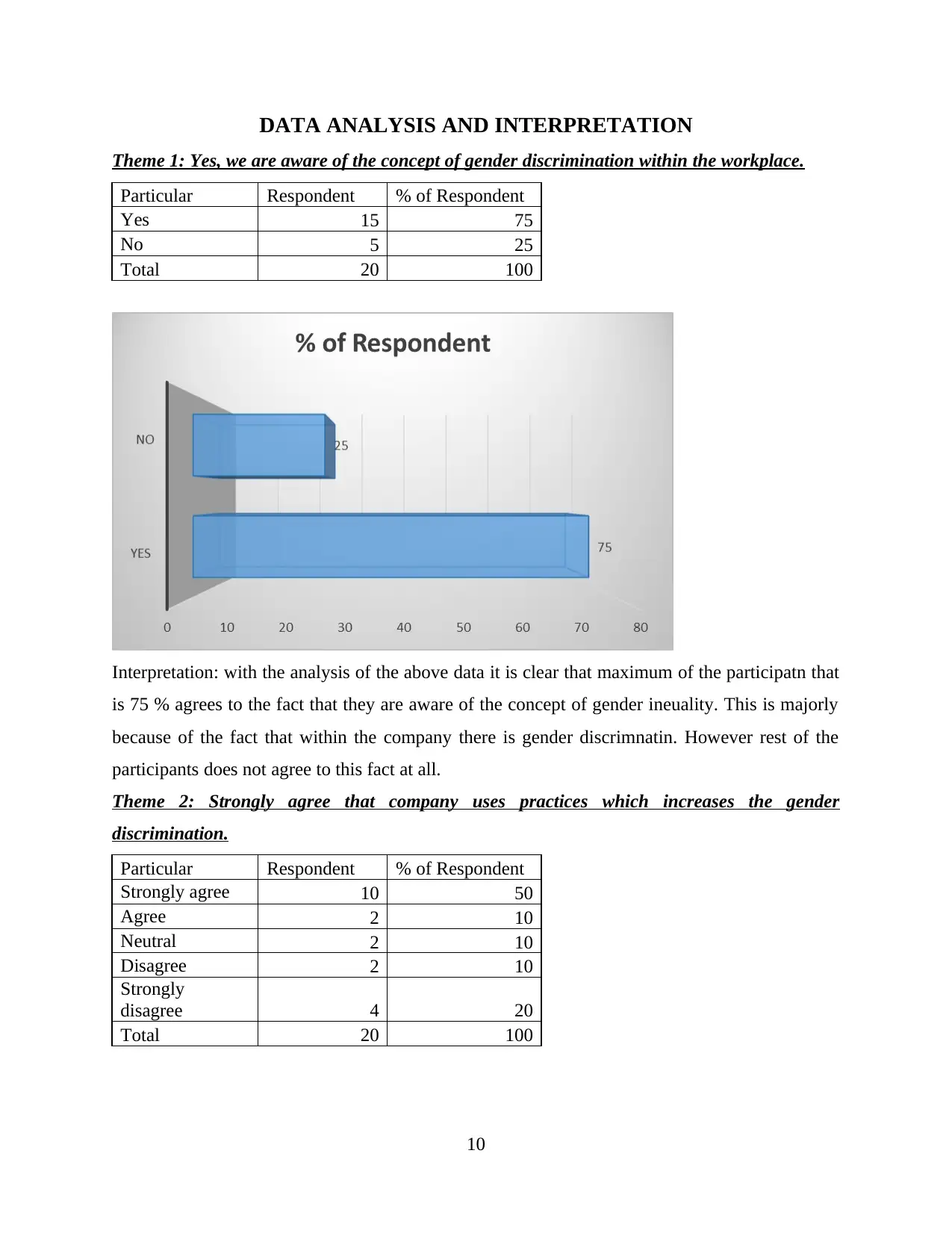
DATA ANALYSIS AND INTERPRETATION
Theme 1: Yes, we are aware of the concept of gender discrimination within the workplace.
Particular Respondent % of Respondent
Yes 15 75
No 5 25
Total 20 100
Interpretation: with the analysis of the above data it is clear that maximum of the participatn that
is 75 % agrees to the fact that they are aware of the concept of gender ineuality. This is majorly
because of the fact that within the company there is gender discrimnatin. However rest of the
participants does not agree to this fact at all.
Theme 2: Strongly agree that company uses practices which increases the gender
discrimination.
Particular Respondent % of Respondent
Strongly agree 10 50
Agree 2 10
Neutral 2 10
Disagree 2 10
Strongly
disagree 4 20
Total 20 100
10
Theme 1: Yes, we are aware of the concept of gender discrimination within the workplace.
Particular Respondent % of Respondent
Yes 15 75
No 5 25
Total 20 100
Interpretation: with the analysis of the above data it is clear that maximum of the participatn that
is 75 % agrees to the fact that they are aware of the concept of gender ineuality. This is majorly
because of the fact that within the company there is gender discrimnatin. However rest of the
participants does not agree to this fact at all.
Theme 2: Strongly agree that company uses practices which increases the gender
discrimination.
Particular Respondent % of Respondent
Strongly agree 10 50
Agree 2 10
Neutral 2 10
Disagree 2 10
Strongly
disagree 4 20
Total 20 100
10
Paraphrase This Document
Need a fresh take? Get an instant paraphrase of this document with our AI Paraphraser
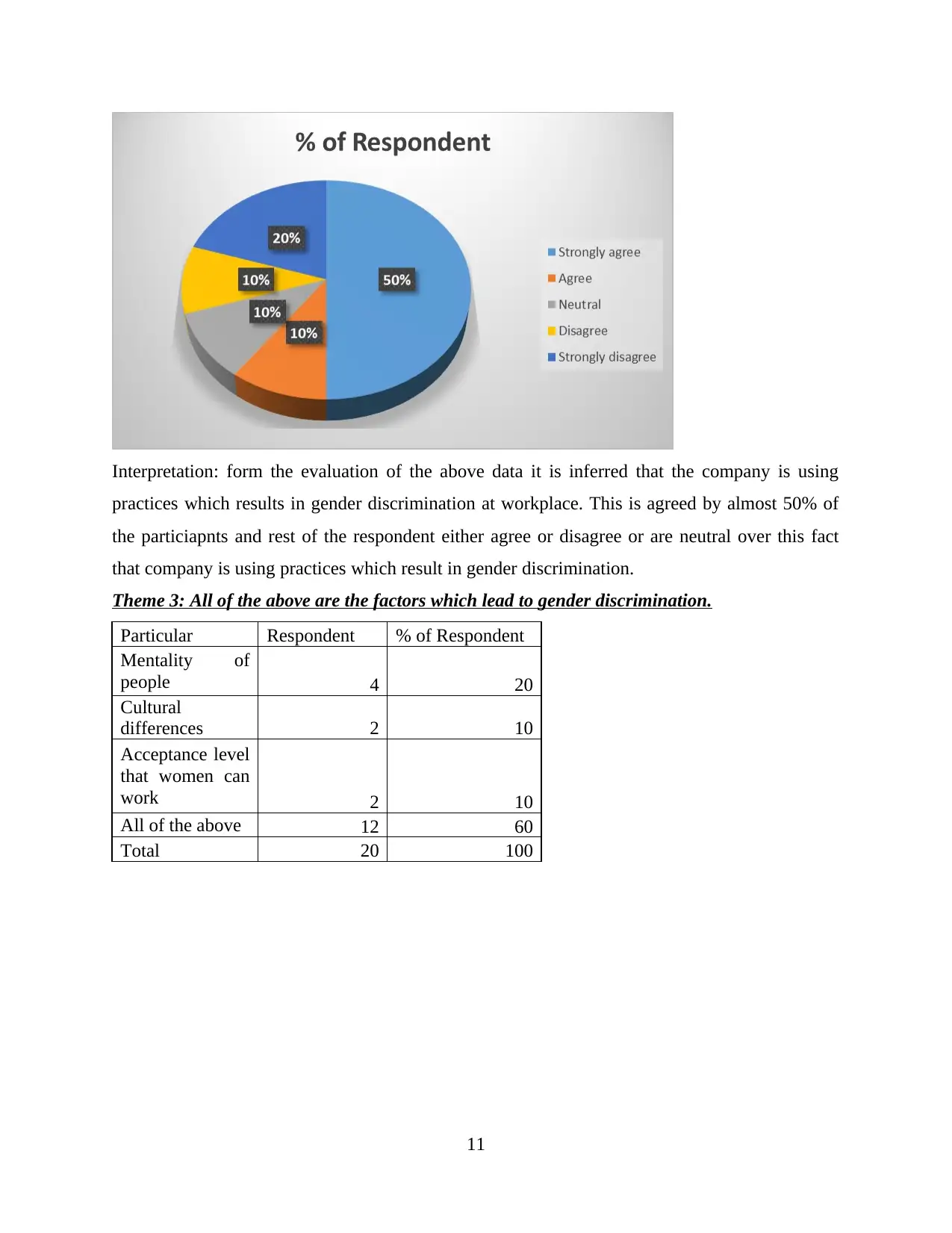
Interpretation: form the evaluation of the above data it is inferred that the company is using
practices which results in gender discrimination at workplace. This is agreed by almost 50% of
the particiapnts and rest of the respondent either agree or disagree or are neutral over this fact
that company is using practices which result in gender discrimination.
Theme 3: All of the above are the factors which lead to gender discrimination.
Particular Respondent % of Respondent
Mentality of
people 4 20
Cultural
differences 2 10
Acceptance level
that women can
work 2 10
All of the above 12 60
Total 20 100
11
practices which results in gender discrimination at workplace. This is agreed by almost 50% of
the particiapnts and rest of the respondent either agree or disagree or are neutral over this fact
that company is using practices which result in gender discrimination.
Theme 3: All of the above are the factors which lead to gender discrimination.
Particular Respondent % of Respondent
Mentality of
people 4 20
Cultural
differences 2 10
Acceptance level
that women can
work 2 10
All of the above 12 60
Total 20 100
11
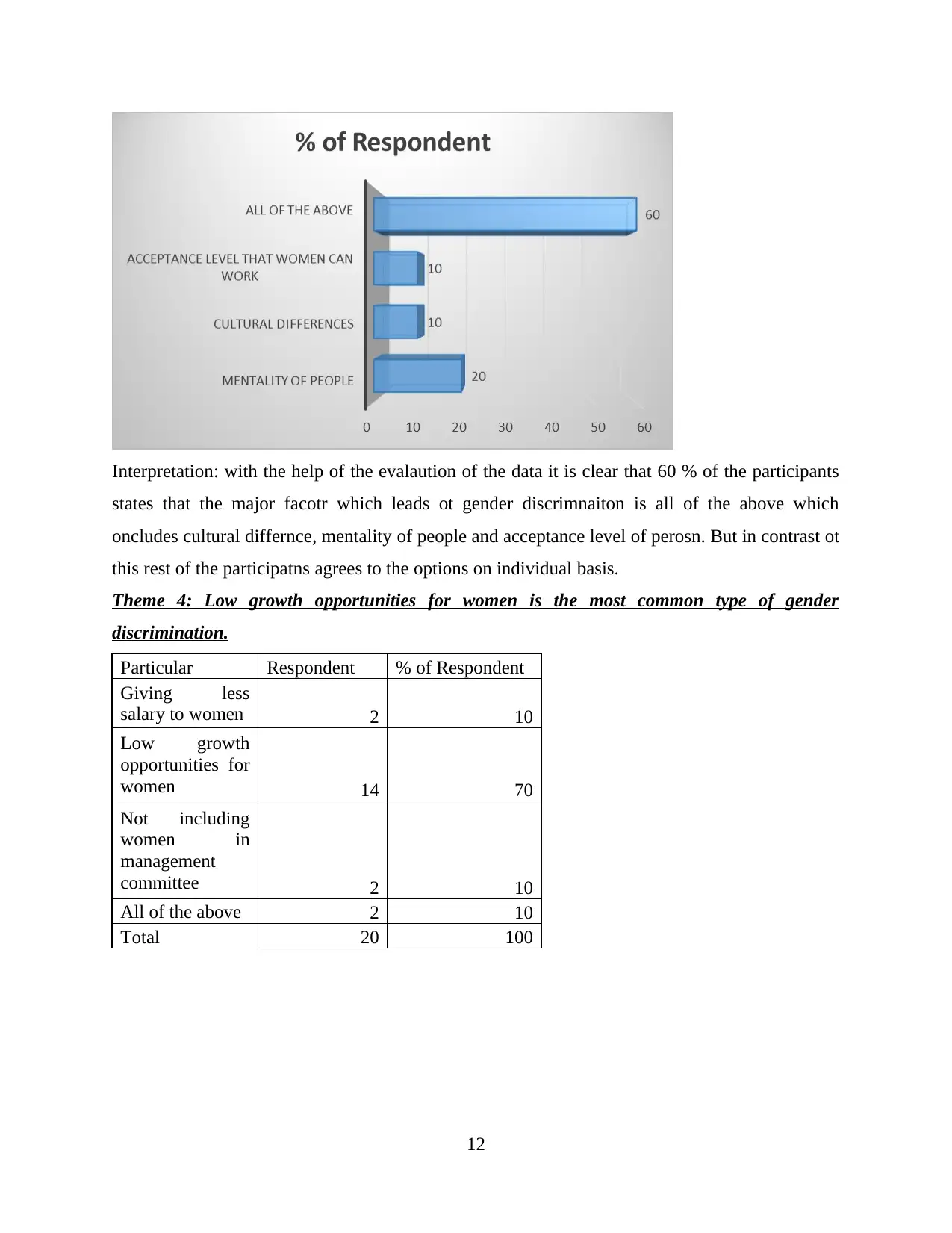
Interpretation: with the help of the evalaution of the data it is clear that 60 % of the participants
states that the major facotr which leads ot gender discrimnaiton is all of the above which
oncludes cultural differnce, mentality of people and acceptance level of perosn. But in contrast ot
this rest of the participatns agrees to the options on individual basis.
Theme 4: Low growth opportunities for women is the most common type of gender
discrimination.
Particular Respondent % of Respondent
Giving less
salary to women 2 10
Low growth
opportunities for
women 14 70
Not including
women in
management
committee 2 10
All of the above 2 10
Total 20 100
12
states that the major facotr which leads ot gender discrimnaiton is all of the above which
oncludes cultural differnce, mentality of people and acceptance level of perosn. But in contrast ot
this rest of the participatns agrees to the options on individual basis.
Theme 4: Low growth opportunities for women is the most common type of gender
discrimination.
Particular Respondent % of Respondent
Giving less
salary to women 2 10
Low growth
opportunities for
women 14 70
Not including
women in
management
committee 2 10
All of the above 2 10
Total 20 100
12
⊘ This is a preview!⊘
Do you want full access?
Subscribe today to unlock all pages.

Trusted by 1+ million students worldwide
1 out of 22
Related Documents
Your All-in-One AI-Powered Toolkit for Academic Success.
+13062052269
info@desklib.com
Available 24*7 on WhatsApp / Email
![[object Object]](/_next/static/media/star-bottom.7253800d.svg)
Unlock your academic potential
Copyright © 2020–2025 A2Z Services. All Rights Reserved. Developed and managed by ZUCOL.





